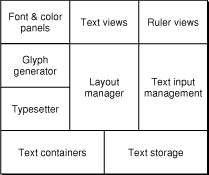Text System Architecture
The text-handling component of any application presents one of the greatest challenges to software designers. Even the most basic text-handling system must be relatively sophisticated, allowing for text input, layout, display, editing, copying and pasting, and many other features. But these days developers and users commonly expect even more than these basic features, requiring even simple editors to support multiple fonts, various paragraph styles, embedded images, spell checking, and other features.
The Cocoa text system provides all these basic and advanced text-handling features, and it also satisfies additional requirements that are emerging from our ever more interconnected computing world: support for the character sets of the world’s living languages, powerful layout capabilities to handle various text directionality and nonrectangular text containers, and sophisticated typesetting capabilities including control of kerning and ligatures. Cocoa’s text system is designed to provide all these capabilities without requiring you to learn about or interact with more of the system than is necessary to meet the needs of your application.
For most developers, the general-purpose programmatic interface of the NSTextView class is all you need to learn. NSTextView provides the user interface to the text system. If you need more flexible, programmatic access to the text, you’ll need to learn about the storage layer and the NSTextStorage class. And, of course, to access all the available features, you can learn about and interact with any of the classes that support the text-handling system.
Figure 1 shows the major functional areas of the text system with the user interface layer on top, the storage layer on the bottom, and, in the middle region, the components that interpret keyboard input and arrange the text for display.
The text classes exceed most other classes in the Application Kit in the richness and complexity of their interface. One of their design goals is to provide a comprehensive set of text-handling features so that you’ll rarely need to create a subclass. Among other things, a text object such as NSTextView can:
Control whether the user can select or edit text.
Control the font and layout characteristics of its text by working with the Font menu and Font panel (also called the Fonts window).
Let the user control the format of paragraphs by manipulating a ruler.
Control the color of its text and background.
Wrap text on a word or character basis.
Display graphic images within its text.
Write text to or read text from files in the form of RTFD—Rich Text Format files that contain TIFF or EPS images, or attached files.
Let another object, the delegate, dynamically control its properties.
Let the user copy and paste text within and between applications.
Let the user copy and paste font and format information between NSText objects.
Let the user check the spelling of words in its text.
Graphical user-interface building tools (such as Interface Builder) may give you access to text objects in several different configurations, such as those found in the NSTextField, NSForm, and NSScrollView objects. These classes configure a text object for their own specific purposes. Additionally, all NSTextFields, NSForms, NSButtons within the same window—in short, all objects that access a text object through associated cells—share the same text object, called the field editor, reducing the memory demands of an application. Thus, it’s generally best to use one of these classes whenever it meets your needs, rather than create text objects yourself. But if one of these classes doesn’t provide enough flexibility for your purposes, you can create text objects programmatically.
Text objects typically work closely with various other objects. Some of these—such as the delegate or an embedded graphic object—require some programming on your part. Others—such as the Font panel, spell checker, or ruler—take no effort other than deciding whether the service should be enabled or disabled.
To control layout of text on the screen or printed page, you work with the objects that link the NSTextStorage repository to the NSTextView that displays its contents. These objects are of the NSLayoutManager and NSTextContainer classes.
An NSTextContainer object defines a region where text can be laid out. Typically, a text container defines a rectangular area, but by creating a subclass of NSTextContainer you can create other shapes: circles, pentagons, or irregular shapes, for example. NSTextContainer isn’t a user-interface object, so it can’t display anything or receive events from the keyboard or mouse. It simply describes an area that can be filled with text. Nor does an NSTextContainer object store text—that’s the job of an NSTextStorage object.
A layout manager object, of the NSLayoutManager class, orchestrates the operation of the other text handling objects. It intercedes in operations that convert the data in an NSTextStorage object to rendered text in an NSTextView object’s display. It also oversees the layout of text within the areas defined by NSTextContainer objects.
© 1997, 2009 Apple Inc. All Rights Reserved. (Last updated: 2009-04-08)
